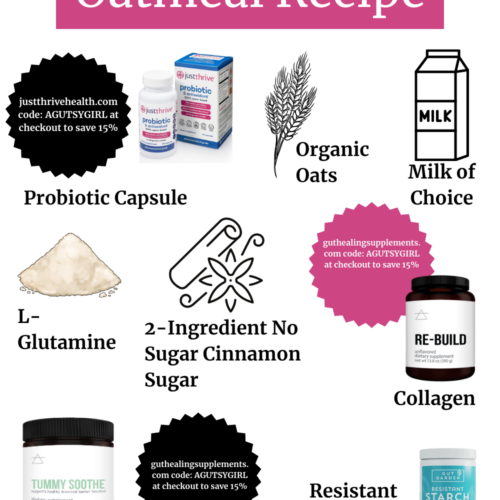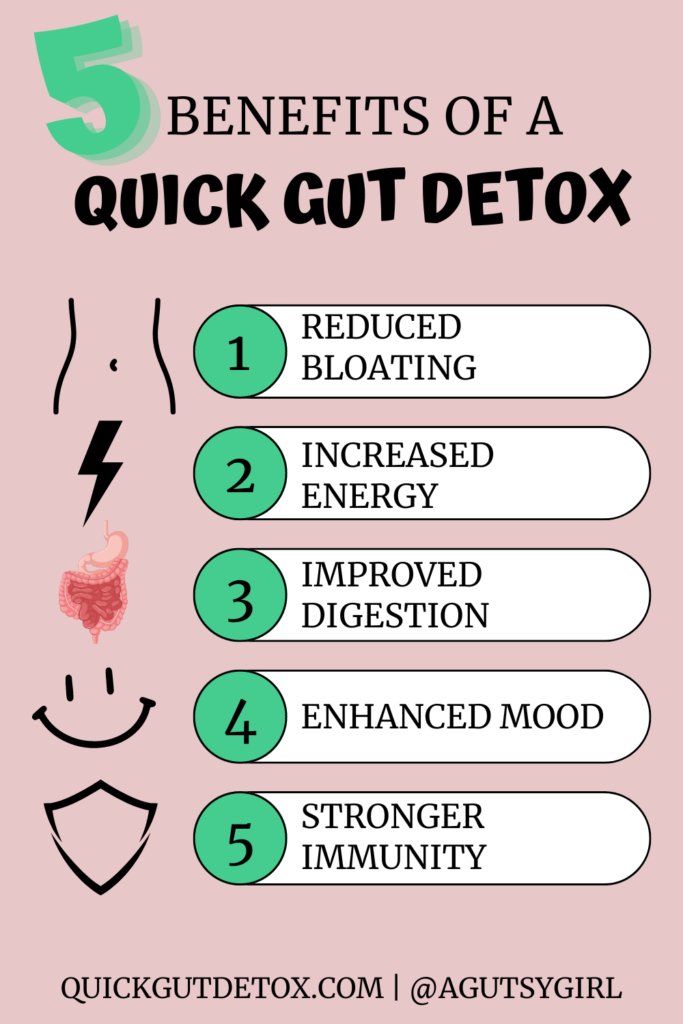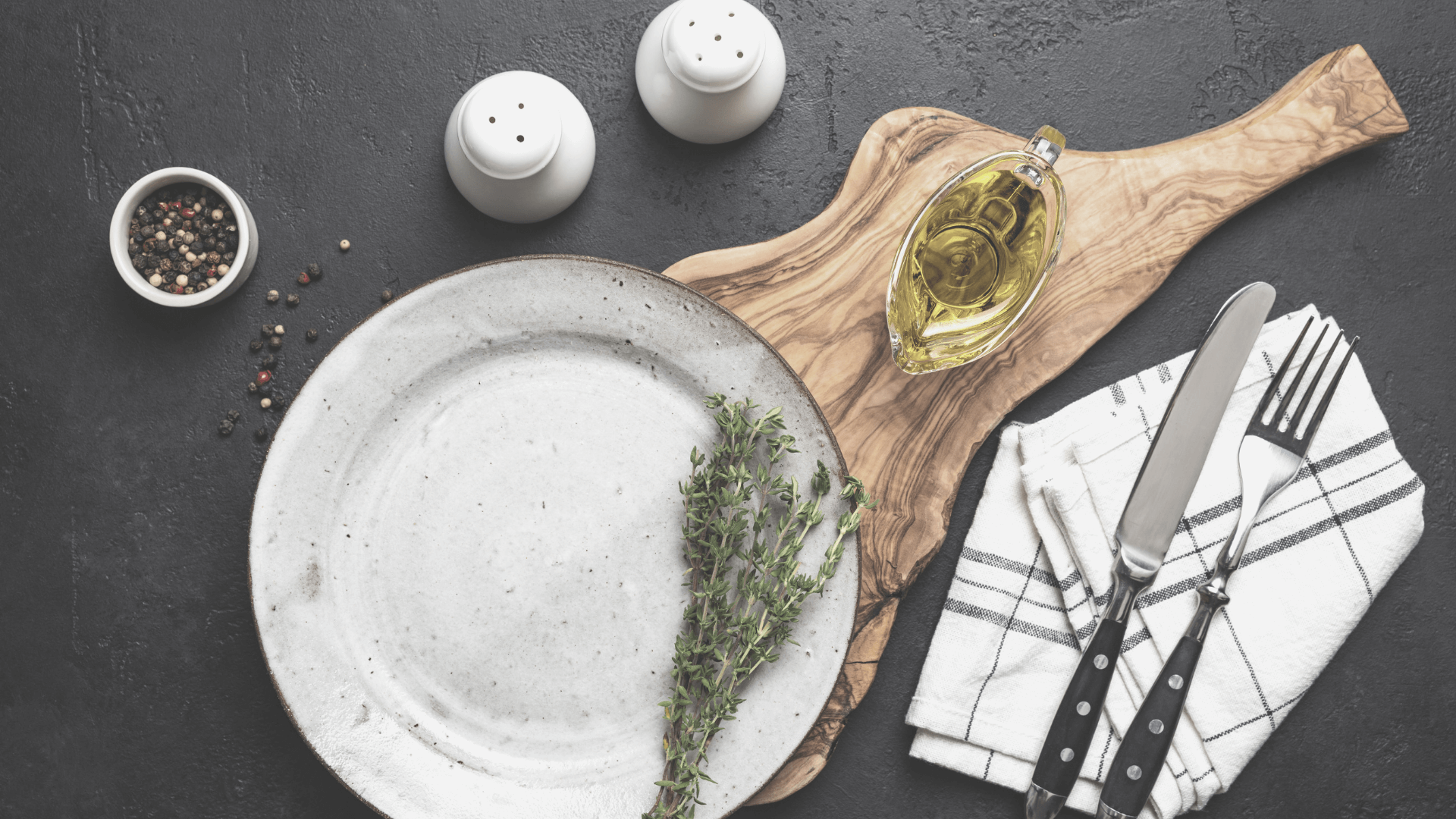Is oatmeal high in oxalates, and if not, what is the best gut healthy boosted oatmeal recipe?
This gut healthy boosted oatmeal is helping me currently thrive. So I wanted to share it with you.
When I’m eating gut healing and/or gut healthy things, it’s very intentional. I know the reasons behind almost every food and supplement as it relates to my personal situation.
But here’s the thing, each time I share recipes with oatmeal as a breakfast idea, I get a million different questions regarding, “….but is oatmeal a healthy choice for my gut?”
And therefore, while this bowl is incredible for me right now, it might not be for you. Listen to your gut!
Is Oatmeal High in Oxalates
Click HERE to save this post on ‘is oatmeal high in oxalates’ for later.

There are many reasons why people question oatmeal, but today I want to focus on it as it relates to oxalate intake.
In Antinutrients for your Gut Healing Journey, here is what I state regarding oxalates:
Oxalates and Your Gut
Oxalate is a compound found in some foods, and it is also produced as a waste product by the body. It exits the body through the urine. Too much oxalate may cause kidney stones in some people.
Oxalates fall into the antinutrient category because they bind to calcium and prevent its absorption in the human body.
According to Dr. Sara Gottfried,
You have to be sensitive to them, because of your genetics, gut bacteria (dysbiosis, or missing the microbes that process them), or nutritional deficiencies, like vitamin B6, magnesium, and thiamine. The gene involved in oxalate breakdown is called SLC26A1. The bacteria that break down oxalates are the Oxalobacter formigenes and Lactobacillus species. Eating too many oxalates, like more than 250 mg a day, also puts you at risk for problems.
High-Oxalate FOODS
While this list consists of otherwise nutritious foods, they do all contain high amounts of oxalate.
- spinach, raw and cooked
- dark, leafy greens (in general)
- soy
- almonds
- black tea
- instant coffee
- berries
Find a great full oxalate food chart HERE.
Make note: According to The Paleo Mom, oxalates are not even an antinutrient. Oxalate is a salt.
Okay, so now I want to add more to this conversation to help you even more.
Low Oxalate Food
The following foods would fit into a low-oxalate diet:
Meat and Seafoods:
- All meats and fish are safe
Breads and grains:
- white rice
- hummus
- corn flour
- corn bran
- ground flaxseeds
- oat bran
Vegetables:
- Brussel Sprouts
- Cauliflower
- Cabbage
- Mushrooms
- Onions
- Peas, green (fresh or frozen)
- Potatoes, white
- Radishes
Fruit/Juices:
- Apple & apple juice
- Avocado
- Banana
- Cherries, bing
- Grapefruit, fruit & juice
- Grapes, green
- Mangoes
- Melons: cantaloupe, casaba, honeydew, watermelon
- Nectarines
- Pineapple juice
- Plums, green or yellow
Beverages:
- Beer, bottled light
- Carbonated cola (limit to 12 oz/day)
- Distilled alcohol 1 oz
- Lemonade or limeade without added vitamin C
- Milk (whole, low fat, or skim) Buttermilk
- Wine: red, rose, white (3-4 oz)
- Yogurt with allowed milk
Eggs and Dairy:
- Eggs 1 whole
- Cheese
- Butter
- Milk
- Buttermilk
Seasoning and Condiments:
- fresh or dried herbs, such as basil, oregano, peppermint and sage
- sweet flavor additives, such as sugar and honey
- Dijon mustard, ketchup and jelly
As you can see, there are still a huge variety of foods that you can eat.
But what’s the problem for Gutsy Women and Intake of High Oxalate Foods
As stated previously from Dr. Sara,
Eating too many oxalates, like more than 250 mg a day, also puts you at risk for problems.
Here is other research on oxalate levels as they relate to your gut:
- The NIH states, “The potential impact of a probiotic/therapeutic approach may be clinically significant in PH1 and could also extend to a much larger population of idiopathic oxalate stone formers who comprise ~12% of Americans, individuals with enteric hyperoxaluria, and an emerging population of hyperoxaluric patients who have undergone bariatric surgery and develop kidney stone disease as a consequence.”
- Better Biome states, “In addition, growing data indicate that the gut microbiome plays a critical role in the production of oxalates. People who have a history of antibiotic treatments are more likely to form calcium oxalate kidney stones. Oxalates can be created in larger amounts by a disordered gut microbiome. Paradoxically, this increase in oxalates can then damage the healthy microbiome.”
- Dr. Jill states, “As a rule, you don’t want your body to absorb oxalates. If oxalates pass through the GI tract without causing problems, then they aren’t much of an issue. A major concern is when oxalates are consumed alongside a gut condition, like leaky gut syndrome, which could increase the amount of oxalates absorbed by the body.”
Honestly? For the general Gutsy community, I’m not overly concerned by oxalate concentration but you might be.
And if you are, then let’s talk about ways to decrease oxalate consumptions.
5 ways to lower your chances of forming calcium oxalate stones
- Drink enough fluids. The number one thing you can do is to drink enough fluids, like water.
- Avoid eating too much protein. Eating too many foods high in protein can cause stones to form.
- Include the right amount of calcium-rich foods in your diet.
- Eat fewer oxalate-rich foods. See above for my list.
- Be cognizant of how you’re preparing your food. Because oxalates are water soluble, they can be reduced by blanching, boiling, or steaming with the liquid discarded. Fermentation reduces oxalates. Cooking in milk or macerating in whey can also mitigate oxalate exposure. Sprouting can help too.
Sources: HERE (National Kidney Foundation) and HERE
And now for the good news….
My gut healthy boosted oatmeal is likely to be juuuuuust fine for those of you who might be concerned with high oxalate content.
What is a Gut Healthy Boosted Oatmeal?
First, why do I call the oatmeal bowl this? Because that’s exactly what it is. It’s basically just oats with various supplements added in to maximize gut health, an oatmeal porridge of sorts.
Instead of ingredients like oats, peanut butter, chocolate, spices, and milk, it’s simply oats with supplement additions. Well, for the most part anyways.
Now that I’m super confident in where I stand on my gut healing journey, my goal is to boost gut health. Every single day I mix elements from my gut healing journey and overall gut health for the best possible outcome.
And yes, it’s all working.
Gut Healthy Boosted Oatmeal Recipe
Click HERE to save this gut healthy boosted oatmeal recipe without a lot of oxalates for later.

Let’s just dig right in to what I all added in this oatmeal bowl.
I’ll share the ingredients, in order of how I added them during the video.
Side note: Almost all ingredients below have a code so you can save on your order. You’ll find the probiotic, resistant starch, L-Glutamine, Tummy Soothe, collagen and even the sugar for the no-sugar cinnamon sugar discounts HERE via the Master Gutsy Spreadsheet.
Also, at the bottom of each ingredient, I mention if it’s a “gut health” or “gut healing” appropriate. Remember, this is my opinion through my research. With every single one of the supplemental ingredients, please be sure to check with your doctor and/or nutritionist.
Organic Rolled Oats
Yes, of course I know that oats are a grain, starch, and even oftentimes frowned upon as an antinutrient. I’m well aware of it all. For that reason, for many of you in the depths of your gut-healing journey, you may choose to not use oats. That’s okay. You do you.
I love organic quick oats because they are a good source of fiber and are very filling, low-FODMAP, and contain no sugar.
Is Oatmeal Gluten Free?
Oats are naturally gluten-free, but not all oats are certified gluten free.
Because I don’t have Celiac disease, these are perfectly okay for me.
[I will note that this would be the perfect instance for me to take the Gluten Away, though.]
Probiotic Capsule
You’re wondering, “A capsule in oatmeal? But how?” Simple. Step one: open capsule. Step two: pour capsule contents into the oatmeal. Stir, and boom!
Hear me on this one, though. You cannot do this for all probiotics.
This is just one of the hundreds of reasons why I use Just Thrive Probiotic.
It’s strong enough to survive all temperatures, and can easily be opened to incorporate into anything from ice cream to baked goods.
Learn more about the Just Thrive Probiotic HERE.
Gut Health or Gut Healing? Probiotics are subjective. But many people, even those with SIBO, have had success with the Just Thrive Probiotic. If you’re absolutely miserable, you could always start with 1/4 – 1/2 capsule, see how you feel and adjust accordingly. You could also skip this one.
Tummy Soothe
No matter what, building the strongest immune system you can is best. This is a product that, even when I don’t eat oatmeal for breakfast, I’m taking daily.
With this oatmeal bowl, I’m working on both gut healing and gut health. Because 70-90% of the immune system lies in the gut, adding in this (non-flavored) powder makes perfect sense.
Simply add in a scoop of Tummy Soothe and reap these extra health benefits:
- Supports gut health
- Aids in healthy intestinal cells
- Supports gut immune function
- Promotes GI barrier integrity
Gut health or gut healing? Both.
L-Glutamine
L-Glutamine is to help build and support the intestinal lining. In fact, it was one of my stomach lining support supplements.
A bonus for this supplement is that it also helps preserve muscle mass.
I’ve written an entire post about L-Glutamine for Gut Healing HERE.
Gut health or gut healing? Both.
Keto Collagen
Collagen is another supplement that’s good for the gut lining, helping to re-build it.
It provides the amino acids needed to repair and rebuild the intestinal wall and prevent a leaky gut.
This collagen is also keto and it includes nothing more than collagen peptides (i.e. no fillers, sugars, or other additives).
Gut health or gut healing? Both.

Resistant Starch (prebiotic)
Until I was healed, I didn’t research too much about prebiotics.
Well, then I healed and began the intensive Gut Health Course via the Institute for Integrative Nutrition.
And now I know, without-a-doubt, how critical prebiotics are long-term for the microbiome.
In fact, some of you in the gut healing phase can even consider adding in prebiotics. I do not think this is a supplement to add in for those of you with active (and miserable) SIBO or any other type of overgrowth.
Prebiotics help create a diverse microbiome. And a diverse microbiome leads to a stronger microbiome.
Gut health or gut healing? Gut health, and in some cases gut healing.
How to Make Oatmeal Taste Good
Now, if you just ate the oatmeal as-is from above, you might not think it tastes super great because….no sugar.
Therefore, here are two miscellaneous things I add to my own oatmeal:
- 2-Ingredient No Sugar Cinnamon Sugar Yes, just two ingredients, and you can see how I make this HERE. You don’t have to use this as your “flavor” if you don’t want to. I just love it because it adds a spicy/sugary element without any extras really.
- Plant-Based Milk It’s mentioned in the video, but even though I love thick oatmeal, I do enjoy adding some milk at the end. You can choose whatever works for you. [Grab my guide to the choosing the best plant-based milk HERE.]
Note: I never choose soy milk, and if you must follow a low oxalate diet then you might even choose dairy products like whole, raw milk (my absolute fave!)
Gut Healthy Boosted Oatmeal Recipe Card

Gut Healthy Boosted Oatmeal Recipe
Ingredients
- 1 cup organic, gluten-free oats 1/2 cup uncooked, 1 cup cooked
- 1 probiotic capsule I use the Just Thrive Health probiotic
- 1 scoop Tummy Soothe via guthealingsupplements.com
- 1 tsp L-Glutamine powder
- 1 scoop collagen
- 1 scoop Resistant Starch
- no-sugar cinnamon sugar as desired
- milk of choice as desired
Instructions
- Make the oats according to the package, and scoop cooked oats into a bowl.
- Empty the probiotic capsule contents into the oatmeal, and stir until completely mixed together.
- Next, place the scoop of Tummy Soothe (the immune booster) into the oatmeal. Again, stir until completely mixed together.
- Add in the L-Glutamine, and stir until completely mixed together.
- Then, add in the collagen, Re-Build. Again, stir until completely mixed together.
- Finally, add the resistant starch and stir until completely mixed together.
- Prior to eating, top with the 2-Ingredient No Sugar Cinnamon sugar and/or milk of choice and/or anything else desired.
Notes
More Gut Healthy Recipes
If simple concoctions like this are interesting to you and you want to learn all about a healing + healthy gut, then you’ll love the 21-Day Quick Gut Detox.
If you liked this post, you might also enjoy:
Xox,
SKH
🤰 bloating be gone! weight loss through optimal gut health for women
💃ʜᴇᴀʟ ʏᴏᴜʀ ɢᴜᴛ. ʜᴇᴀʟ ʏᴏᴜʀ ʟɪfe.
🫶🏻 founder gutbyome.com








![Three Day Detox Plan [a gut reset without feeling miserable]](https://agutsygirl.com/wp-content/uploads/2022/12/the-first-three-featured.png)
Probiotics really do help a lot with overall health. Their benefits are immeasurable. Thank you so much 🙂